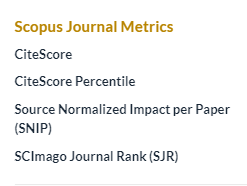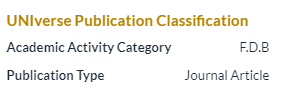-
Schnellstart
-
Modul-Anleitungen
-
Themenbereiche
-
FAQs und Kontakt
Metriken Definition
Inhalt
Metriken in Bezug auf Publikationen sind im ursprünglichen in englischer Sprache formuliert. Um Risiken durch Übersetzungsfehler auszuschliessen ist diese Hilfeseite nicht in deutscher Sprache verfügbar.
The University of Basel has signed the San Francisco Declaration on Research Assessment (DORA) and is committed to assessing research quality in a differentiated manner, with an emphasis on scientific content. Journal-based metrics must not be used for the assessment of research performance of individuals. Article-based metrics can complement a comprehensive assessment of researchers – taking into account the limitations of specific metrics and disciplinary research practices.

Scopus Publication Metrics
The Scopus citation count is only including the number of times the publication was cited by articles from the journals that Scopus covers. Be aware that Scopus does not count citations from every journal published around the world or any discipline, nor does this method count all citations from books, conference proceedings, dissertations/theses, etc.”
Note that the Citation Count is dynamic and changes over time.

Scopus Journal Metrics
CiteScore
Journal metrics can be an indicator for evaluating the collective impact of the journal’s total output but not the impact of an author’s individual contribution. They are sensitive towards different biases.

CiteScore Percentile
CiteScore Percentile indicates the relative standing of a journal in its subject field. A 98th CiteScore Percentile means the journal is in the top 2% of its subject field. This number can be used to compare sources in different subject fields
Source Normalized Impact per Paper (SNIP)
SNIP measures a source’s contextual citation impact by weighting citations based on the total number of citations in a subject field. It helps you make a direct comparison of sources in different subject fields.
»Link: How is SNIP (Source Normalized Impact per Paper) used in Scopus?
SCImago Journal Rank (SJR)
SJR is weighted by the prestige of a journal. Subject field, quality, and reputation of the journal have a direct effect on the value of a citation.
SJR assigns relative scores to all of the sources in a citation network. Its methodology is inspired by the Google PageRank algorithm, in that not all citations are equal. A source transfers its own prestige, or status, to another source through the act of citing it. A citation from a source with a relatively high SJR is worth more than a citation from a source with a lower SJR.
UNIverse Publication Classification
Academic Activity Category
Academic Activity is described here: »Link: Einführung Akademische Aktivitäten

Publication Type
More Information here: »Link: Publikationen (Nach Typ)
Crossref Publication Metrics
Crossref Citation Count
Note that citations are only retrieved from works with a Crossref DOI and will differ from citation counts provided by other services. Not all scholarly publications are registered with Crossref and not all publishers opt to deposit their references.

Dimensions Publication Metrics
Publication Citations
More Information here: »Link: What are ‚publication citations‘?
Recent Citations
More Information here: »Link: Which indicators are used in Dimensions, and how can these be viewed?
Relative Citations Ratio
More Information here: »Link: What is the RCR? How is the RCR score calculated?
Field Citation Ratio
More Information here: »Link: What is the FCR? How is it calculated?